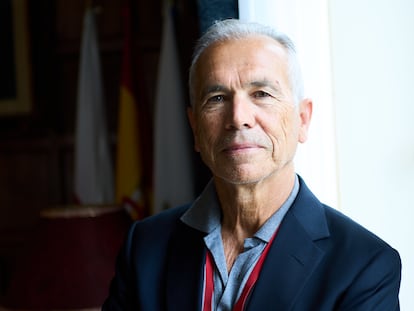Polio is circulating again in the West: What we know so far about transmission in New York and London
Local spread of the disease has been confirmed in the US city, where one man has been paralyzed by the infectious disease
The poliovirus is circulating again in the West. A virus that was on the way to global eradication has been detected in recent months in the wastewater of New York and London. This is not unusual, since it can appear in the fecal remains of vaccinated people with the attenuated pathogen. What’s different now is that the poliovirus – which causes the infectious disease polio – has been recorded in an adult in the United States, something that has not happened for a decade, and that samples from the United Kingdom suggest there is local transmission of the disease.
How did the virus get there? To answer this question, it is first necessary to understand the two types of vaccines that are used against polio. In countries where transmission is eradicated, an intramuscular vaccine is used. This contains the inactive virus, which is enough to prevent it from spreading in an environment where the pathogen is no longer circulating in the wild and most of the population is vaccinated. The second type of vaccine is made up of oral drops with a live attenuated virus, which is used in countries where polio continues to circulate. It produces antibodies in the blood, as well as the oral and intestinal mucosa. “With this vaccine, the immunized person would not develop the disease nor would they be able to infect others if they become infected with the wild virus,” explain researchers José Jiménez and Ana María Ortega-Prieto, from King’s College London, in an article in The Conversation.
The only two countries where polio remains endemic are Pakistan and Afghanistan, with 12 cases and one so far this year, respectively. Normally, when polio is detected in fecal remains in the wastewater, it comes from the excretion of people from these countries, which is not a major problem. What has happened now is that the virus is not just being detected in wastewater, it’s infecting people.
It’s still not fully confirmed that there is local circulation in London, but the European Center for Disease Control (ECDC) has warned: “The poliovirus levels and the genetic diversity among the isolates suggests some level of virus transmission both in the areas where positive samples were found and in adjacent ones.”
Local circulation has been confirmed in New York, where one adult has been paralyzed due to the virus. According to the US Centers for Disease Control and Prevention (CDC), this case, is just “the tip of the iceberg.” “There are a number of individuals in the community that have been infected with poliovirus,” Dr. José Romero, from the CDC, told news network CNN. “The spread is always a possibility because the spread is going to be silent.”
As was seen during the Covid-19 pandemic, when a case is detected and its origin is unknown, it is normally a sign of uncontrolled transmission. “For every one case of paralytic polio identified, hundreds more may be undetected,” said State Health Commissioner Dr. Mary T. Bassett in a statement. This is partly due to the fact that most people who contract the poliovirus are asymptomatic. Only in about 1% of cases does the virus cause problems: if it enters the central nervous system, it can cause paralysis and muscle atrophy.
What are the consequences of these outbreaks? In both London and New York, vaccination rates are lower than in the rest of their respective countries, meaning there is an elevated risk for children, who mainly affected by this disease. In London, authorities have already launched a vaccination campaign to offer booster doses to one million children between the ages of one and nine.
The road to polio eradication
The spread of polio is limited, at least in countries with high vaccination coverage. But these recent cases show that the virus still presents a risk and completely eradicating it is a complicated task, even if it seemed within reach.
The Global Polio Eradication Initiative (GPEI) was launched in 1988 with the aim of eradicating polio just as smallpox has been eradicated. In general terms, the program has been a success: the number of polio cases worldwide have dropped 99% since its creation.
Only Pakistan and Afghanistan, where Islamic fundamentalism makes vaccination campaigns difficult, report a few cases each year. And Nigeria, the other country where there is wild poliovirus (i.e. not the virus is transmitted by the attenuated vaccines), has not reported a single case since 2016.
The secret to this achievement is mass vaccination: first with the oral vaccine and then, when the country is already free of the disease, with the vaccine given by injection. Keeping vaccination levels high is key to curbing the virus.
According to UNICEF data, global vaccination levels dropped between 2019 and 2021 by 5%. In other words, 25 million children stopped receiving their doses. Vaccination rates are the lowest they have been in the last 30 years: 81% for diphtheria, tetanus and whooping cough, which are considered a good indicator for other conditions. This means it is likely that polio coverage is at similarly low levels.
Tu suscripción se está usando en otro dispositivo
¿Quieres añadir otro usuario a tu suscripción?
Si continúas leyendo en este dispositivo, no se podrá leer en el otro.
FlechaTu suscripción se está usando en otro dispositivo y solo puedes acceder a EL PAÍS desde un dispositivo a la vez.
Si quieres compartir tu cuenta, cambia tu suscripción a la modalidad Premium, así podrás añadir otro usuario. Cada uno accederá con su propia cuenta de email, lo que os permitirá personalizar vuestra experiencia en EL PAÍS.
¿Tienes una suscripción de empresa? Accede aquí para contratar más cuentas.
En el caso de no saber quién está usando tu cuenta, te recomendamos cambiar tu contraseña aquí.
Si decides continuar compartiendo tu cuenta, este mensaje se mostrará en tu dispositivo y en el de la otra persona que está usando tu cuenta de forma indefinida, afectando a tu experiencia de lectura. Puedes consultar aquí los términos y condiciones de la suscripción digital.
More information
Últimas noticias
Most viewed
- Sinaloa Cartel war is taking its toll on Los Chapitos
- Oona Chaplin: ‘I told James Cameron that I was living in a treehouse and starting a permaculture project with a friend’
- Reinhard Genzel, Nobel laureate in physics: ‘One-minute videos will never give you the truth’
- Why the price of coffee has skyrocketed: from Brazilian plantations to specialty coffee houses
- Silver prices are going crazy: This is what’s fueling the rally











































